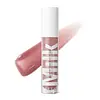What's inside
What's inside
 Key Ingredients
Key Ingredients

 Benefits
Benefits

 Concerns
Concerns

 Ingredients Side-by-side
Ingredients Side-by-side

Polybutene
Hydrogenated Polyisobutene
EmollientHydrogenated Polybutene
Prunus Armeniaca Kernel Oil
MaskingEthylene/Propylene/Styrene Copolymer
Octyldodecanol
EmollientSilica Dimethyl Silylate
EmollientRicinus Communis Seed Oil
MaskingPersea Gratissima Oil
Skin ConditioningRosa Canina Seed Oil
EmollientRubus Idaeus Seed Oil
EmollientOryza Sativa Bran Extract
Skin ConditioningHelianthus Annuus Extract
EmollientRosmarinus Officinalis Leaf Extract
AntimicrobialButylene/Ethylene/Styrene Copolymer
Aroma
Caprylyl Glycol
EmollientEthylhexylglycerin
Skin ConditioningTocopherol
AntioxidantPentaerythrityl Tetra-Di-T-Butyl Hydroxyhydrocinnamate
AntioxidantIron Oxides
CI 77742
Cosmetic ColorantCI 73360
Cosmetic ColorantCI 15850
Cosmetic ColorantCI 77891
Cosmetic ColorantPolybutene, Hydrogenated Polyisobutene, Hydrogenated Polybutene, Prunus Armeniaca Kernel Oil, Ethylene/Propylene/Styrene Copolymer, Octyldodecanol, Silica Dimethyl Silylate, Ricinus Communis Seed Oil, Persea Gratissima Oil, Rosa Canina Seed Oil, Rubus Idaeus Seed Oil, Oryza Sativa Bran Extract, Helianthus Annuus Extract, Rosmarinus Officinalis Leaf Extract, Butylene/Ethylene/Styrene Copolymer, Aroma, Caprylyl Glycol, Ethylhexylglycerin, Tocopherol, Pentaerythrityl Tetra-Di-T-Butyl Hydroxyhydrocinnamate, Iron Oxides, CI 77742, CI 73360, CI 15850, CI 77891
Sucrose Acetate Isobutyrate
Simmondsia Chinensis Seed Oil
EmollientButyrospermum Parkii Butter
Skin ConditioningAgave Tequilana Leaf Extract
AstringentDipentaerythrityl Hexahydroxystearate/Hexastearate/Hexarosinate
Skin ConditioningJojoba Esters
EmollientIsononyl Isononanoate
EmollientTocopheryl Nicotinate
AntioxidantHelianthus Annuus Seed Wax
Skin ConditioningHelianthus Annuus Seed Oil
EmollientLycium Barbarum Fruit Extract
AstringentPersea Gratissima Oil
Skin ConditioningAcacia Decurrens Flower Wax
EmollientHibiscus Sabdariffa Flower Extract
Skin ConditioningRuby Powder
Skin ConditioningSapphire Powder
Tocopherol
AntioxidantTocopheryl Acetate
AntioxidantSilica Dimethyl Silylate
EmollientOctyldodecanol
EmollientCaprylic/Capric Triglyceride
MaskingPolyglycerin-3
HumectantVanillin
MaskingGlycerin
HumectantWater
Skin ConditioningSilica
AbrasiveMica
Cosmetic ColorantSodium Benzoate
MaskingPotassium Sorbate
PreservativeAroma
Citral
PerfumingLimonene
PerfumingLinalool
PerfumingCI 77891
Cosmetic ColorantIron Oxides
CI 73360
Cosmetic ColorantSucrose Acetate Isobutyrate, Simmondsia Chinensis Seed Oil, Butyrospermum Parkii Butter, Agave Tequilana Leaf Extract, Dipentaerythrityl Hexahydroxystearate/Hexastearate/Hexarosinate, Jojoba Esters, Isononyl Isononanoate, Tocopheryl Nicotinate, Helianthus Annuus Seed Wax, Helianthus Annuus Seed Oil, Lycium Barbarum Fruit Extract, Persea Gratissima Oil, Acacia Decurrens Flower Wax, Hibiscus Sabdariffa Flower Extract, Ruby Powder, Sapphire Powder, Tocopherol, Tocopheryl Acetate, Silica Dimethyl Silylate, Octyldodecanol, Caprylic/Capric Triglyceride, Polyglycerin-3, Vanillin, Glycerin, Water, Silica, Mica, Sodium Benzoate, Potassium Sorbate, Aroma, Citral, Limonene, Linalool, CI 77891, Iron Oxides, CI 73360
 Reviews
Reviews

Ingredients Explained
These ingredients are found in both products.
Ingredients higher up in an ingredient list are typically present in a larger amount.
Aroma refers to an ingredient, or mixture of ingredients, that impart or mask a flavor.
The name is slightly confusing. This is because INCI associates aroma with flavor instead of smell.
Here is the official definition from the The International Cosmetic Ingredient Dictionary and Handbook:
“Aroma is a term for ingredient labeling used to identify that a product contains a material or combination of materials normally added to a cosmetic to produce or to mask a particular flavor.”
INCI shows the only purpose of aroma to be "flavouring".
However, due to regulation differences, some companies may use aroma in place of parfum.
In Canada, this ingredient only has to be listed in concentrations above 1%.
Learn more about AromaCi 73360 is a synthetic red-pink dye.
Ci 77891 is a white pigment from Titanium dioxide. It is naturally found in minerals such as rutile and ilmenite.
It's main function is to add a white color to cosmetics. It can also be mixed with other colors to create different shades.
Ci 77891 is commonly found in sunscreens due to its ability to block UV rays.
Learn more about CI 77891Octyldodecanol is a fatty alcohol. It is primarily used to enhance the texture of products.
As an emulsifier, Octyldodecanol helps prevent the oils and waters from separating. It also prevents ingredients from creating foam when shaken.
Octyldodecanol is created by reducing fatty acid to an alcohol.
Due to its high molecular weight, it does not get absorbed into the skin.
Learn more about OctyldodecanolPersea Gratissima Oil is also known as avocado oil.
Avocado Oil has antioxidant properties. It is mostly made up of the glycerides of fatty acids. About 67% of these fatty acids is made up of oleic acid. Palmitic acid and linoleic acid are also present.
These fatty acids help hydrate and soften the skin. It may increase collagen content in the skin. Collagen helps keep your skin plump and firm. This ingredient helps reduce inflammation and has not shown to clog pores.
This ingredient may not be fungal-acne safe due to its high fatty acid content.
Avocados also have B vitamins, vitamin K, vitamin C, vitamin E, and potassium.
Learn more about Persea Gratissima OilThis silica is mainly used to thicken oils and suspend particles in oils. It is not water soluble.
According to the manufacturer, it:
The manufacturer also claims this ingredient to be useful in makeup.
In lipstick formulations, this ingredient improves color payoff, reduces pigment settling, and reduces oil bleeding. This ingredient also improves the grip of powder products such as dry shampoos.
Learn more about Silica Dimethyl SilylateTocopherol (also known as Vitamin E) is a common antioxidant used to help protect the skin from free-radicals and strengthen the skin barrier. It's also fat soluble - this means our skin is great at absorbing it.
Vitamin E also helps keep your natural skin lipids healthy. Your lipid skin barrier naturally consists of lipids, ceramides, and fatty acids. Vitamin E offers extra protection for your skin’s lipid barrier, keeping your skin healthy and nourished.
Another benefit is a bit of UV protection. Vitamin E helps reduce the damage caused by UVB rays. (It should not replace your sunscreen). Combining it with Vitamin C can decrease sunburned cells and hyperpigmentation after UV exposure.
You might have noticed Vitamin E + C often paired together. This is because it is great at stabilizing Vitamin C. Using the two together helps increase the effectiveness of both ingredients.
There are often claims that Vitamin E can reduce/prevent scarring, but these claims haven't been confirmed by scientific research.
Learn more about TocopherolThis ingredient is a combination of red, black, and yellow iron oxide pigments. This combination of colors is usually found in foundation, because it results in a "skin" color.